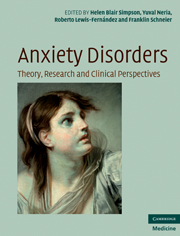Book contents
- Anxiety Disorders
- Dedication
- Anxiety Disorders
- Copyright page
- Contents
- Contributors
- Foreword
- Preface
- 1 Introduction: the need for interdisciplinary approaches
- Section 1 Evolving concepts of anxiety
- 2 The epidemiology of anxiety disorders
- 3 Development of the nosology of anxiety disorders
- 4 The emergence of social anxiety disorder as a major medical condition
- 5 Anxiety as signal, symptom, and syndrome
- 6 New concepts in the evolution and development of anxiety
- Section 2 Challenges in diagnosing pathological anxiety
- Section 3 Understanding the causes of anxiety
- Section 4 Treatment of anxiety: current status and controversial issues
- Index
6 - New concepts in the evolution and development of anxiety
from Section 1 - Evolving concepts of anxiety
Published online by Cambridge University Press: 10 November 2010
- Anxiety Disorders
- Dedication
- Anxiety Disorders
- Copyright page
- Contents
- Contributors
- Foreword
- Preface
- 1 Introduction: the need for interdisciplinary approaches
- Section 1 Evolving concepts of anxiety
- 2 The epidemiology of anxiety disorders
- 3 Development of the nosology of anxiety disorders
- 4 The emergence of social anxiety disorder as a major medical condition
- 5 Anxiety as signal, symptom, and syndrome
- 6 New concepts in the evolution and development of anxiety
- Section 2 Challenges in diagnosing pathological anxiety
- Section 3 Understanding the causes of anxiety
- Section 4 Treatment of anxiety: current status and controversial issues
- Index
Summary
- Type
- Chapter
- Information
- Anxiety DisordersTheory, Research and Clinical Perspectives, pp. 59 - 68Publisher: Cambridge University PressPrint publication year: 2010

